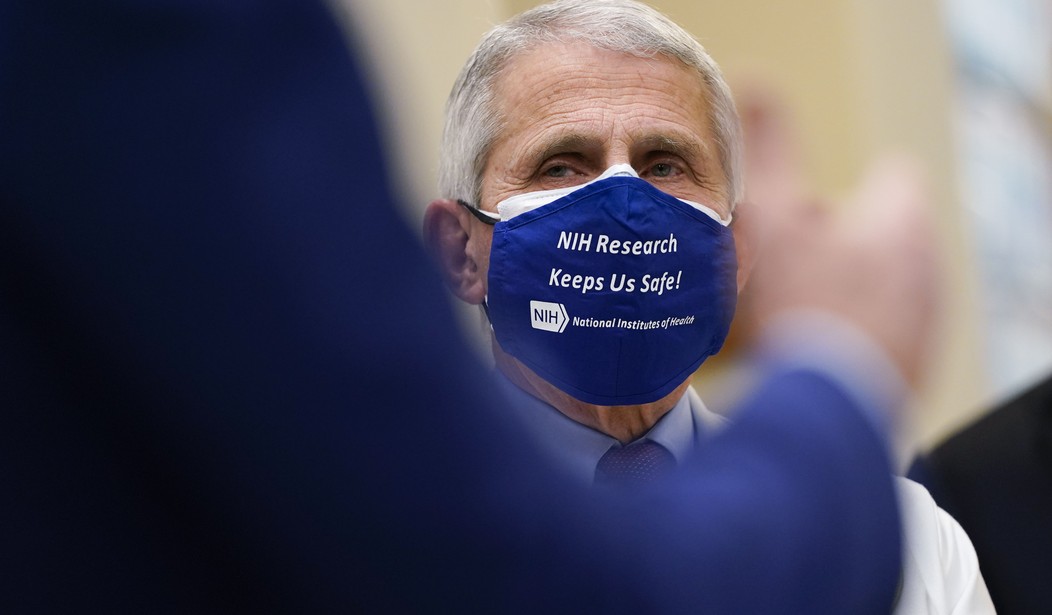If the headline sounds familiar, it’s because the last focus group Luntz did with GOPers who are iffy on the vaccine also found them chilly to Fauci. Which, you would think, would matter to Team Biden since Republicans are among the demographics who are least likely to get vaccinated. If the pro-vax message isn’t getting through because of hostility to the messenger, then change the messenger.
But they just keep on running him out there for the cameras because Democrats love him, never mind that Democrats overwhelmingly are already sold on getting vaccinated.
At some point polling like this has to the matter to the feds leading the vaccination PR effort, right?
Earlier this month, YouGov found Fauci earning sky-high trust among Democrats only & struggling among all other groups (R's, independents, etc). He is no longer an effective public health messenger for much of the country, yet he remains ubiquitous in that role. pic.twitter.com/ziIODBpIXB
— Guy Benson (@guypbenson) April 18, 2021
If they won’t take the pollsters’ word for it, will they take Luntz’s?
“The further we go into the vaccination process, the more passionate the hesitancy is,” Luntz said after the session. “If you’ve refused to take the vaccine this long, it’s going to be hard to switch you.”…
Unlike a similar focus group five weeks ago, when most participants told Luntz and Frieden that the session persuaded them to get shots, attendees Sunday said they were swayed only moderately by doctors’ urging — or not moved at all…
One figure was roundly panned at the focus group: Anthony S. Fauci, director of the National Institute of Allergy and Infectious Diseases. Every participant said they preferred hearing from politicians over the medical expert, who has been pilloried by conservative media for months over his coronavirus warnings.
“The data have shown that unfortunately Dr. Fauci has been politicized, and we need different messengers, because even the right messages coming from the wrong messengers aren’t always helpful,” Castrucci said, noting his foundation’s polling found Americans trust their personal doctors more than the government’s top infectious-disease doctor.
Interestingly, the “pause” on the Johnson & Johnson vaccine didn’t seem to faze the participants on Luntz’s panel. What fazed them was the head of Pfizer recently speculating that people would need a third shot as a booster at some point this fall. Go figure that those who are reluctant to get one or two shots would be put off by the idea of getting three. “I feel like this is not going to end. I mean, we’re just going to be shot up and shot up and shot up,” said one.
What Luntz told WaPo about vaccine hesitancy getting more stubborn among the holdouts as the pool of unvaccinated Americans shrinks may be starting to show up in the data. Note the trendline:
💉VACCINE DATA UPDATE (April 21)💉
📊2.6M doses today; 7-day avg=3.02M/day
🇺🇸US: 216M doses total⚠️We're seeing ongoing flattening of the 7-day around 3M, equal to yesterday. Daily total = to last Tues, down from April 7
Data: https://t.co/0eOgSRgh2J pic.twitter.com/m2yLMumExV
— Drew Armstrong (@ArmstrongDrew) April 21, 2021
The downward turn began right around the time that J&J was paused due to blood-clot fears. Hmmmm. Nate Silver noted last night that we did 1.8 million shots yesterday versus 2.5 million the Tuesday before, which also seems like a bad sign. Between the new jitters about side effects and the fact that we’re gradually exhausting the supply of Americans who are gung ho to get vaxxed, we may already be approaching the proverbial “wall.”
And if we are, that’s not great. Just 26 percent have been fully vaccinated, 40 percent partly. Assuming that everyone who’s already had one shot ends up getting both (which doesn’t always happen), having just 40 percent of the population immunized probably isn’t going to get us to herd immunity. Even if we guesstimate that another 25 percent of Americans already have natural immunity from being infected and, further, that no one in that group overlaps with the vaccinated group (which of course isn’t true), 65 percent total immunity also is short of scientists’ best guesses of what we’ll need in order to slow the spread to a trickle. Some believe we’ll have to have upwards of 85 percent vaxxed in order to do that.
Could we hit that target once children are eligible to be vaccinated? It’s hard to believe that a parent who’s skeptical about being vaccinated themselves would allow their child to take the risk. And even some parents who are pro-vax for themselves may be anti-vax when it comes to their kids, reasoning that the risk of a child suffering a serious illness from infection is so small that it’s not worth exposing them to the risk of vaccine side effects in order to mitigate it.
All of which is to say, how do we reach the remainder of the population now that we’re through the group that was eager to be vaccinated? Experts think it’s time to move from the “Fauci begging everyone to get the shot 12 times a day on TV” stage to the concierge stage, in which case maybe the White House’s messaging problem with Fauci is already basically solved. They don’t need one ubiquitous national spokesman anymore. They need hundreds of thousands of local spokesmen — namely doctors, since people who are reluctant to get vaxxed tend to say they’d be more likely to do so if their own physician recommended it. The problem is how to get the product into the hands of individual doctors, particularly ones in far-flung rural places who might not have many patients.
Yet having individual doctors administer the vaccine poses a logistical challenge for pharmaceutical companies and the Biden administration, which ships doses to states in large quantities. One vaccine maker, Pfizer-BioNTech, ships 1,170 doses in a single pallet; the other, Moderna, ships packets of 10 vials containing 100 doses.
Those amounts are unsuitable for doctors’ offices and smaller settings, which have been the focus of Alabama’s vaccination effort. Dr. Harris said the vaccine packaging “has been disastrous for us.”
Private employers may be the next pressure point. The private sector is eager to jump in and help educate employees — and even administer vaccines, said Kathryn Wylde, the president of the Partnership for New York City, the city’s leading business organization.
Either way, we’re shifting from eager recipients coming to the vaccine to the vaccine being brought to holdouts where they work and receive medical care. So maybe Fauci doesn’t matter so much anymore.
One nagging issue with the concierge approach, though: What to do about young adults, who are less likely to seek/need care at a doctor’s office and therefore may not be particularly reachable through their personal physicians? They’re one of the biggest vaccine-holdout groups in the population because of the low risk of serious illness that COVID presents to them. If you can’t get them vaxxed at the doctor, how do you do it?
Maybe Israel’s “a shot for a shot” gimmick would work. It’s time for the FDA to get creative.
Here’s Biden celebrating a milestone. Remember the original underwhelming “100 million shots in 100 days” target? We’ve done 200 million in 93. Fantastic. But we’re about to slow down.
200 million shots pic.twitter.com/Db6jY8NqVJ
— Acyn (@Acyn) April 21, 2021








